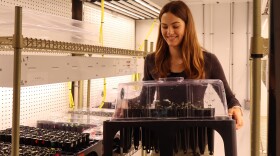LUKE BURBANK, host:
All right. You're looking out. Delegates from nearly 190 countries are gathering on the island of Bali today to kick off two weeks of climate discussions. You notice, Alison, they never have those meetings in Krakow or Detroit.
ALISON STEWART, host:
(unintelligible)
BURBANK: Their goal is to update the 15-year-old global climate agreement, which is going to be tough, considering that the U.S. - arguably the most important piece in the entire puzzle - is not interested in signing the pact. Australia just did, actually, leaving the U.S. as the lone remaining holdout. But here's the thing: Even the countries that did sign the Kyoto Protocol back in 1997, they've seen their emissions rise. And so what is the answer? I mean, maybe it's a new scientific idea we haven't even heard of, which is why this week, we're bringing you a series of interviews we're calling…
(Soundbite of song, "Theme from The A-Team")
BURBANK: …It's Just So Crazy, It Might Work - dumping iron shavings into the ocean to create a big carbon dioxide converter, blocking the sun's rays with a giant particle umbrella. But first, today, giant mechanical trees. You heard right.
A guy named Klaus Lackner of Columbia University's Earth Institute has been working on a device which would remove CO2 from the atmosphere. He calls it a mechanical tree, even though it doesn't really look like a tree. But it does some of the same things.
Professor KLAUS LACKNER (Geophysics, Columbia University Earth Institute): Just like the leaves of a tree have air blowing over them, and they manage to extract some of the CO2 as it floats over the leaf's surface, this device has surfaces over which the wind blows, and it gives up a fraction of its CO2 as it goes through. So the idea of this device is to capture carbon dioxide out of the atmosphere.
BURBANK: But that is where the comparison to a tree ends, at least, aesthetically, because it doesn't look like a tree. I read you described it as a football goalpost with some hanging blinds in the middle? Or…
Prof. LACKNER: Yes, it doesn't look like a tree, because it's just has functionally this one part in common. It doesn't, like a normal tree, try to convert this with sunshine into starches. So the leaves of this tree do not have to be exposed to the sunshine, so they are stacked much more tightly. And, consequently, this synthetic tree is capable of collecting much more CO2 out of the wind than an ordinary tree would.
BURBANK: So you got this idea for this sort of giant filter that could be put up that would take out the carbon dioxide as the air passed through this sort of giant filter. What happens to the CO2 after that, though?
Prof. LACKNER: Once you have the CO2, you have it in a concentrated, pressurized form, and I would expect in the very short term, you will use that CO2, for example, in enhanced oil recovery. Because at that point, the CO2 has still a value, and you inject it on the ground and you will drive additional oil out. You now make more CO2 from the oil, but on the other hand, you have taken the CO2 from the last batch and put it away.
BURBANK: Oh, so there is somewhere to put this, and there is a way to sort of take it out of the game, potentially?
Prof. LACKNER: Yes. And there are two steps. The first one is you inject it underground, and you sort of now hold it in places which are akin to gas wells, but they are reversed engineered gas wells filled with CO2, and you would keep it there for a long time. That technology, I think, is ready today. So we could start with that. The debate I have with the advocates of it is that I believe if you look out on a hundred-year time scale, we may not have enough of that. So it's just simply not enough space…
BURBANK: Enough room to store this carbon dioxide.
Prof. LACKNER: Enough room to store to all of that CO2. And one of the reasons I'm saying that is if you take 50 years of the U.S. production, you would have a layer of liquid - CO2, the density of water - which is about two inches thick, all over the United States. So somehow, sooner or later, I expect we will have to look at options which go beyond just injecting it into the (unintelligible) underground.
BURBANK: Tight. That's only the temporary solution, it sounds like.
Prof. LACKNER: My group sort of started pushing on that, is that mineral sequestration, where you make carbonates, is another option. Right now, this is still too expensive. We will need somewhere around $80 to $100 per ton of CO2 to bind a ton of CO2 to these minerals and store it that way, so that is too expensive.
My view is that we can do all of this if the price of carbon capture and storage comes into the range of $30 per ton of CO2. The disposal itself cannot cost $100 per ton of CO2. On the other hand, we look at fuel cells. We look at photovoltaic devices, where we are perfectly willing to assume that over the next 20, 30 years, we can drive down the price substantially.
BURBANK: Well, let's say for the sake of argument that, you know, this filter works. It manages to capture the CO2. We manage, then, to take the CO2 and put it somewhere, either back in the ground or integrate it back into some sort of level of the kind of geologic record that it's okay. Let's say all that happens. How many of these - for lack of a better term - trees, you know, atmosphere scrubbers that you're proposing, how many of them would we need in the U.S. to actually make a difference?
Prof. LACKNER: You obviously have seen the picture of that goalpost, which was 50 by 60 meters, which, by the way, I'm thinking about it right now would be a very large unit. But that unit would collect the CO2 from roughly 15,000 cars, so this gives you a feeling.
BURBANK: So it's - that would be a 50-foot by…
Prof. LACKNER: Fifty meter by…
BURBANK: Fifty meters.
Prof. LACKNER: Fifty meter by 60 meter, which makes it a little smaller than a big windmill…
BURBANK: Okay.
BURBANK: …which has a span of about 100 meters.
BURBANK: So that - something about the size of a small windmill could capture the CO2 from 15,000 cars?
Prof. LACKNER: Correct. Or all the Co2 from 4,000 people. If you simply take the current emissions of the world, you would need 250,000 such units, which sounds like a very large number, but if you think about the world as a whole, that is actually a quite small number compared to what we need to do.
BURBANK: So 250,000 of these mechanical-built scrubber tree goalpost devices, 250,000 of them in the world. What would that cost?
Prof. LACKNER: Well, we believe - and we don't know that yet, right? We are in the early days of this game. My belief is that in the long term, we drive the cost of these things down to roughly $30 per ton of CO2, which would add roughly 25 cents to a gallon of gasoline.
BURBANK: Do you think a lot of why this idea has been so popular is because when somebody talks about building an artificial tree, it's sort of fantastical, and your mind immediately imagines this very cool thing with metal leaves and - people can sort of imagine it, even though that in reality, it looks very different than that. Do you think just the idea that the short description of this is this guy's building mechanical trees that will filter out carbon dioxide, is that really helped you in terms of getting momentum for this idea?
Prof. LACKNER: I could imagine that's true. I think the other part is I think people begin to realize how difficult it is to solve the greenhouse gas problem. And most of the solutions which I offered are solutions which say, well, you have to change your lifestyle. And this is a solution which, in some ways, minimizes the need for lifestyle changes because it does allow you to consume fossil fuels.
Some people say that makes it a bad idea, because we don't need to change our lifestyle. On the other hand, I would argue there are so many people coming along who need to get to as high standard of living, that we really cannot get around having fossil fuel in the mix of energy sources.
BURBANK: That's Klaus Lackner of Columbia University's Earth Institute. By the way, if you want to know about the second part of this equation, capturing carbon and storing it underground, we've got an awesome video from Win Rosenfeld going up on the Web site later today.
STEWART: Believe it or not, the Iowa caucuses - one month from today. We'll discuss, coming up on the BPP. Transcript provided by NPR, Copyright NPR.





